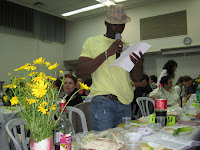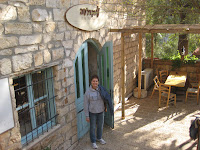




On Monday afternoons I head south on the #25 bus to teach English to 10-11 year old kids at Lev-Jafo (Jaffa) primary school. The route, which takes about 40 minutes or more depending on traffic and the condition of the bus (once it broke down and we had to wait for a replacement), begins at Rehov Yehuda HaMaccabi, winds through central Tel Aviv and deposits me on Yerushaliyim St., the main business street in downtown Jaffa. From the bus stop I enjoy a short walk past the fruit and vegetable market, the fish, meat, and spice shops, the supermarket, hair salons, the many small shops selling clothing and household goods, and the official looking building with its Arabic sign to reach the entrance to the school courtyard. Here a curious sight greets me---two primary schools face each other across a large open plaza/playground. To the left is Weitzman primary school, to the right Lev-Jafo primary school. Why two schools in the same location?
The story behind this arrangement is beginning to sound all too familiar. Initially these two buildings housed one school: the building on the right housed the preschool grades, children from three to six years old (there is a large sand box behind this building), while the building on the left housed the classrooms for the first through sixth grades. Reflecting the population of Jaffa, the children come from Arabic speaking and Hebrew speaking homes. Jaffa is a rather poor community (although experiencing some gentrification) with a mixed population-- Jews from the FSU (former Soviet Union) countries, Yemen, and Ethiopia, and Israeli Arabs (Christian and Muslim). Arab-Israelis (born and raised in Israel with passports and full citizenship rights) constitute 20% of the Israeli population as a whole but the percentage is higher in Jaffo where the breakdown among the 45,000 residents is 30,000 Jews and 15,000 Arabs, one third of whom are Christians.
This mix does not always result in smooth relations. Apparently, eight or nine years ago the parents of the children in the unified school came into conflict over the educational practices and were unable to resolve their differences. The outcome was a split into two schools, both run by the Israeli government—one with students from Arab backgrounds while the other has a mixed Arab and Jewish student body. The principal of the Lev-Jafo school is a youngish, energetic Arabic man and most, but not all, of the teachers in the school are Arabic speakers. The instruction at Lev is in Arabic and Hebrew. The students speak Arabic, Hebrew, and are learning English (sort of). On the other side, at the Weitzman school, the instruction is entirely in Hebrew. The signs on the outside of the main school buildings reflect this difference—Lev-Jafo’s signs are in Hebrew, Arabic and English while Weitzman’s are in Hebrew and English only. Interestingly, many Arabic speaking parents want their children to attend the mixed school and the goal is to keep the ratio at 50-50 Arab/Jewish. However, I have heard that there is some difficulty maintaining the Jewish population and the Weitzman school may close. The more affluent Israeli Jewish families send their children to public or private schools with greater resources. The schools in the southern part of Tel Aviv are less well-endowed than those in northern neighborhoods, with per pupil expenditures much higher in the northern districts. In fact, the Israeli Education Ministry does not allocate as much money per Arab student as it does for the Israeli children. Not surprisingly, the dropout rates are higher in the poorer areas. Interestingly, our Bavli neighbors, Lee and Edna Perlman, in a reversal of the usual flight from the poorer south to richer north, sent their children to the Open Democratic School in Jaffa, because they did not like what they perceived as the materialistic bent of the parents whose children attend the local Bavli-Yerushalmi school. The Open Democratic School, which has a progressive, multicultural orientation, is one example of an integrated “private” (does receive state funding, however) school with a mostly middle class clientele. Some integrated bilingual and multicultural schools do exist, including some successful Arabic-Hebrew preschools, as well as primary schools run by the nonprofit Hand in Hand (
www.handinhand.12.org). But for the most part Arabic-speaking and Jewish students don’t attend the same schools, even in mixed cities such as Jaffa, Haifa, or Akko (Acre). Typically, Arab and Jewish youth don’t have many opportunities to get to know each other. This separation reflects the general geographical, cultural and social segregation between Israeli Arabs and Jews. Even in mixed areas, the two groups don’t live, work, or go to school together, a situation that promotes inequality and gives rise to feelings of fear and/or hostility.
Interestingly, while the instruction in Arab schools is in Arabic, the state-mandated curriculum is the same as that in the Jewish schools, emphasizing Jewish history and Jewish heroes. You can imagine that there are many conflicts over language, religion, holidays, culture and heritage, the history and current politics of Palestinian-Israeli relations, identity, and inequality. I learned much of this from a power point presentation I found on the web by Dr. Tamar Margalit from the Center for Critical Pedagogy and the Kibbutzim College of Education (A Glimpse Into a Mixed Ethnic Elementary School in Jaffa, April 2008). Margalit gives one very telling example of hidden agendas in the curriculum from a math textbook:
A militaristic example from a textbook (5th grade, arithmetic fractions):
In a family there are 4 children: Neta is a soldier and Ival, Anat and Yuval are pupils.
The parents prepared a cake for the soldier’s vacation, and gave the children instructions:
“Divide the cake between all of you, so that the pupils will get equal pieces, and the soldier’s piece will be bigger than the others.”
Suggest how to divide the cake. Decide and write down how much of the cake each child will get.
Margalit outlines efforts made at the Weitzman school to implement a more multicultural approach to education. Student teachers from the Center for Critical Pedagogy worked with the children on several projects to promote cooperative learning and empowerment. Mixed ethnic and multi-aged groups of children chose to work on one of several projects: bilingual school magazine; school design; “I am From Jaffa”; and Children’s Rights. Margalit shares a few quotes about the friendships among the children from different backgrounds but I’m eager to learn more about how the momentum from the projects carried over into the normal school routine and whether the new ways of teaching and learning were sustained.
This week I decided to visit the English tutoring program at the Weitzman school to get a sense of the contrast in the two settings. Here the children spoke to each other in Hebrew rather than the Arabic (with some Hebrew) I hear at Lev. In contrast to the students at Lev---Mohamed, Machmud, Achmed, Aya, Sineen, Weesan, Omar, Isma, and Omar—the names of the Weitzman students reflect a different ethnic mix. At Weitzman the students are Matan, Mordechai, Batya, Avia, Tova, Eden, Shirel, and Christina and Yam, the two girls with whom I worked. This group seemed a bit more focused and, probably because there are more of them, the girls seemed a bit less shy. We had fun talking about animals—what they look like, what sounds they make, where they live, which is their favorite and so on. This was a repeat of the lesson we did with the Lev kid’s on Monday when I learned that Machmud has a brown horse and a cat named Lili and Sineen's teacher told her that the rhinoceros was called a "unicorn". Today I learned that Christina has a blue bird. I’ve met two new tutors this week. Cheryl is a Stanford student who is studying social inequality and working with a professor at Tel Aviv University. Lani moved to Israel one year ago from her home in Charlotte, NC!
“Closing the Gaps”, the afterschool English tutoring program, is run by the Jaffa Institute (
www.jaffainstitute.org), a private non-profit multi-service social welfare organization that offers an impressive array of learning/enrichment activities and prevention /assistance programs to at risk and underserved children and their parents from Jaffa, south Tel Aviv, Bat Yam, and other impoverished areas in Jerusalem and elsewhere.











































